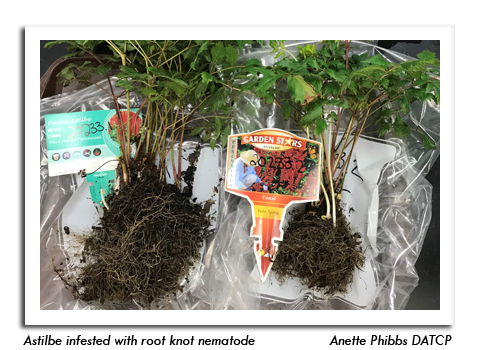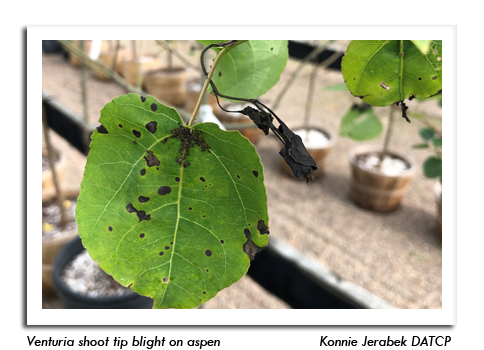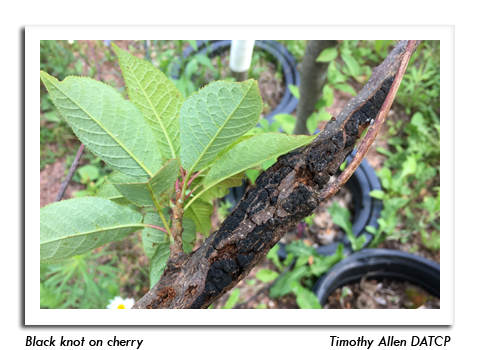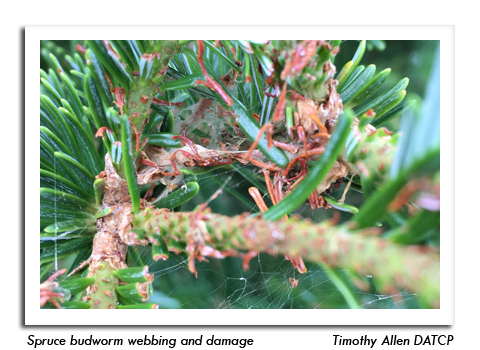
 |
|
|
Nursery & Forest
Volume 65 Number 10 Date 07/08/2020 ROOT KNOT NEMATODE - Root knot nematodes were detected on 'Prince Henry' anemone and astilbe varieties 'Fanal', 'Visions in Red', 'Maggie Daley' and 'Younique Silvery Pink' at two nurseries in Jefferson and Washington counties. The astilbe foliage was severely stunted and wilted, and the belowground root balls were noticeably smaller than normal. Examination of the roots found characteristic knot-like root galls that are created by the female nematodes when they embed in the root tissue to feed and reproduce. The roots, already weakened by the root knot nematode damage, were colonized by fungal pathogens contributing to root decay. Fusarium, Phytophthora or Pythium and Thielaviopsis were the pathogenic fungi identified from the blackened roots. The Northern root knot nematode (Meloidogyne hapla) is a serious problem for commercial growers and home gardeners because these nematodes can infest many ornamentals, vegetables and weeds and are very difficult to control once established in an area. Crop rotation with corn, wheat, oat, rye and French marigolds while controlling weeds may keep nematode populations in check. All infested stock was destroyed. -- Anette Phibbs and Sam Fieweger, DATCP Plant Industry Lab VENTURIA SHOOT TIP BLIGHT - Containerized quaking aspens at a nursery in St. Croix County were showing the black, blighted shoots indicative of this fungal disorder. The initial symptoms appear in May as irregular brown or black spots on the leaf surfaces, which later expand to new shoots and cause a characteristic shepherd's crook. Only young shoots and leaves are susceptible to this disease, though repeated attacks of the fungus on new growth can weaken and predispose trees to invasion by other pathogens. Secondary infection cycles can occur throughout the shoot elongation period if wet conditions prevail. The fungus overwinters in infected shoots, so management recommendations include removing fallen diseased leaves, pruning blighted shoots below the margin between healthy and diseased tissue, and avoiding the most susceptible cultivars. BIRCH DROUGHT STRESS - Birch and other deciduous trees commonly develop chlorotic leaves at this time of year due to heat and drought stress. Although well-established older trees may drop leaves, they are generally not harmed by short-term dryness. However, young trees planted in the last three years are still highly vulnerable to moisture loss and should be regularly watered at least once a week during dry periods. WHITE PINE WEEVIL - Christmas tree growers are reminded to scout pine and spruce fields now for white pine weevil problems. Typical signs of infestation include curled, browned, and wilting young leaders, often with fresh pitch flow at the feeding site. The excess pitch production is the tree's natural defense against wood boring insects. Cultural control by pruning out terminals infested with larvae may reduce weevil populations and reform the tree, but the effective window of pruning is brief and restricted to the late spring/early summer from when the terminals begin wilting until the insects emerge through exit holes. The pruned area should be limited only to the infested part of the terminal, which often may not extend to the next set of branches. Any pruned material must be disposed of off-site since larvae can continue to develop in cuttings. The white pine weevil is known to attack at least 20 different tree species including Norway, blue and black spruce, as well as mugo, Scots and jack pine, with Eastern white pine being the most suitable host for brood development. Although weevil damage rarely results in tree mortality, repeated seasons of infestation can lead to growth reduction, stem deformation, and increased susceptibility to wood decay organisms. MALLOW SAWFLY - Recent inspections found moderate damage to mallow plants caused by this sawfly species. The mallow sawfly infests hibiscus, hollyhock and mallow, severely skeletonizing foliage when populations are high. The larvae are identifiable by their black heads and light green bodies. BLACK KNOT OF CHERRY - A severe infection of this fungal disease was noted on bird cherry trees in Marathon County. The infestation was so extreme that the trees were removed from sale due to the abundance of 'knots' and dead limbs. This common disease of trees and shrubs in the Prunus genus can be managed by pruning out the knots in winter or early spring, before fungal spores are released. Multiple infections of black knot reduce tree vigor and cause eventual decline. SPRUCE BUDWORM - DATCP inspectors found spruce budworm defoliation on Frasier fir Christmas trees in Sawyer County. This native pest has periodic outbreaks in natural stands of spruce and fir. Larvae usually prefer to infect large mature trees, but occasionally defoliate Christmas trees and nursery stock. For smaller nursery or backyard infestations, Bt sprays targeting this insect can be effective if applied weekly to spruce foliage in May when the larvae are small. Applications in June and July should help to control infestations on new growth. -- Timothy Allen, DATCP Nursery Inspector 





|
|
|